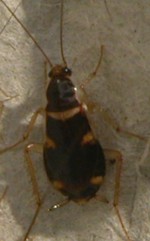Need assistance? Call 800.996.4402

Brown banded cockroaches get their name from the two lighter bands they have across their dark brownish bodies. In addition to the distinctive banding, males have full wings, which reach beyond the tip of their rather pointed abdomens, but females have underdeveloped wings, much shorter than their broad, rounded abdomens. The lighter band markings are much more distinct in nymphs than in adults of either sex.
Male brownbanded cockroaches have been observed to fly indoors. Among cockroach species, brownbanded cockroaches have the most distinctions between sexes. Females have larger abdomen and shorter wings than males. Brownbanded cockroaches often hide their egg cases in or under furniture.
Cockroaches have been reported to spread at least 33 kinds of bacteria, six kinds of parasitic worms, and at least seven other kinds of human pathogens. They can pick up germs on the spines of their legs and bodies as they crawl through decaying matter or sewage and then carry these into food or onto food surfaces. Germs that cockroaches eat from decaying matter or sewage are protected while in their bodies and may remain infective for several weeks longer than if they had been exposed to cleaning agents, rinse water, or just sunlight and air. Recent medical studies have shown that cockroach allergens cause lots of allergic reactions in inner city children. They were even shown to cause asthma in children. These allergens build up in deposits of droppings, secretions, cast skins, and dead bodies of roaches.
Within a room, these roaches tend to prefer warmer, drier, and higher locations than do any of the other urban pest roaches. They are often found in upper cabinets or in other rooms than the kitchens (food preparation areas) or bathrooms.
Good sanitation and habitat reduction, along with vacuuming, surveillance, a baiting program, and some sealing of cracks can usually quickly reduce or eliminate a cockroach population.
For the very best food safety consulting, auditing and training, please visit our strategic partner, CFS Food Safety